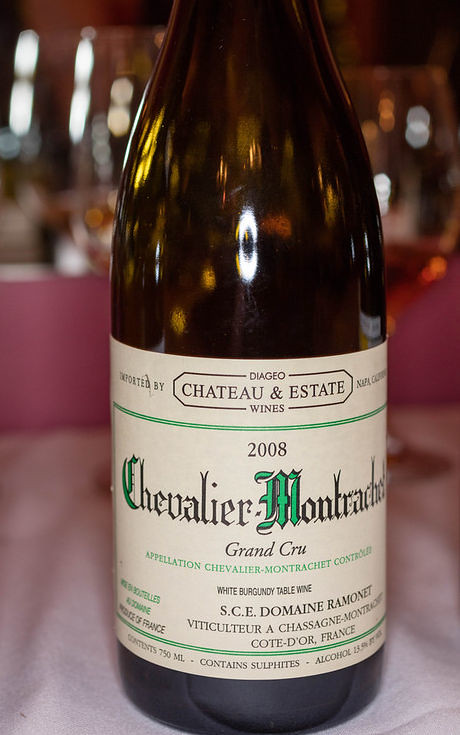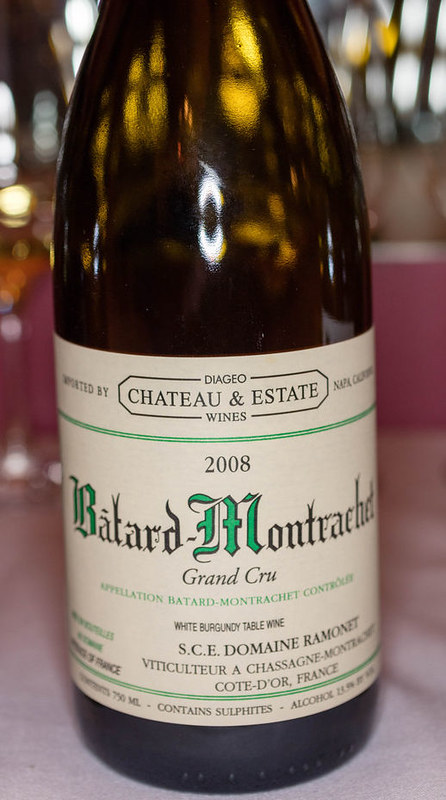On Tuesday March 8, 2016 ten of us gathered at Melisse Restaurant in Santa Monica California for the third and final night of my annual white burgundy vintage assessment and oxidation check dinners. This was the eleventh consecutive year we have held this dinner series and this year we tasted the 2008 vintage, as usual at 7.5 years after the vintage.
The final dinner is called the “Mostly Montrachet” dinner, which describes the wines included. Befitting the name, we tasted 11 different 2008 Montrachets and two wines from Coche-Dury (Corton Charlemagne and Meursault Perrieres).
The first installment of the 2008 vintage dinner, which covered 29 wines from Chablis, Meursault and Corton Charlemagne, was held at Valentino Restaurant on February 9, 2016. You’ll find the tasting results and my tasting notes here.2008 Vintage Assessment and Premox Check Dinner No. 1 - WINE TALK - WineBerserkers
The second night of the 2008 vintage dinners, which covered 25 grand crus from Bienvenues-Batard, Criots-Batard, Batard and Chevalier Montrachet, plus 3 ringers, was held on February 25, 2016 at Valentino Restaurant. You’ll find those tasting notes and results here: TN: 2008 White Burgundy Vintage Assessment Dinner No 2 @ Valentino February 25, 2016 - WINE TALK - WineBerserkers
The private room at Melisse upon our arrival
This photo and the ones below were taken by Andrew Gavin, one of the attendees. Andy has several more photographs of the event on his own blog site, All Things Andy Gavin: http://all-things-andy-gavin.com/
Melisse is one of California’s Michelin Two Star restaurants and with good cause. For many of us it is the best restaurant in Southern California. It is definitely a “must try” restaurant for those of you who may be visiting Los Angeles. (But be forewarned, it’s not inexpensive.) Once again the food and the service were extraordinary. My thanks to Chef-owner Josiah Citrin and Chef de Cuisine Ken Takayama.
Appetizer Course
Wagyu Beef Tartare, Beef Bernaise, Black Truffle Cheese Tart
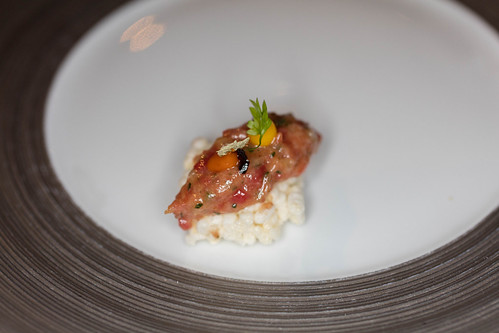
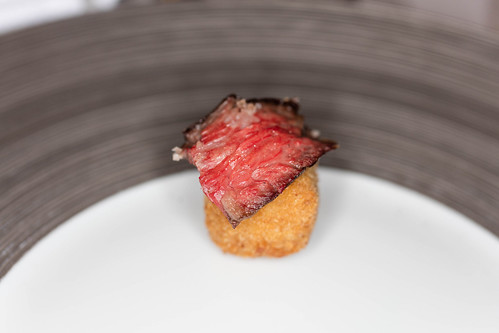
Left: Wagyu Beef Tartare__________________________________ Right: Beef Bernaise – the sauce is within the little puff pastry_
2002 Dom Perignon Champagne (two 750 ml)
Light gold color, aromas of light toast and melon; grapefruit citrus flavors with very nice long minerally finish 94
The Spring Pea Soup served as an Amuse before the first food course
Flight One
Stonington Maine Diver Scallop with Salsify, Polenta, Sauce Perigourdine
#1 [2008 Bouchard Montrachet]
Light gold color; key lime and pears aromas; very refreshing lemon and lime citrus flavors with really nice texture and “shape”; very good acidity; beautiful wine and very elegant long finish. My No. 4 wine of the night. Group Rank: Tied for 4th, 16 points (0/0/2/4/2) 95
#2 [2008 Remoissenet Montrachet]
Light gold color; initially a little reduction, which faded quickly into light pear and tropical fruit aromas; very nice pear fruit with good acidity; this had an unbelievably elegant finish. This wine faded just a little in the late going. My number six wine of the night. Group Rank: 7th place, 10 points (0/1/1/1/1) 94
#3 [2008 Louis Latour Montrachet]
Between light and medium gold color; aromas of pears and botrytis; fulsome, apricot and tropical fruit flavors (botrytis); very sweet finish, like a dessert wine. Heavy botrytis here and not my cup of tea. Group Rank: Tied for 9th (last), 0 points (0/0/0/0/0) 88?
#4 [2008 Le Moine Montrachet]
Deep gold color; heavy, almost overwhelming apricot and some definite sherry aromas, although this is light in comparison with the apricot; on the palate its butterscotch, apricot and sherry. We all unanimously agreed that this wine is partially oxidized. It’s not terrible and you could actually drink it, but it is definitely partially oxidized. Group Rank: Tied for 9th (last), 0 points (0/0/0/0/0) 86—partially oxidized
#5 [2008 Jadot Montrachet]
Just short of medium gold color; aromas of honey and light butterscotch and apple; the wine was lighter on the palate than the aromas would imply; mature medium bodied green apple fruit; definitely mature wine, almost borderline advanced, but not over the hill. Group Rank: Tied for 9th (last) 0 points (0/0/0/0/0) 93
Flight Two
Black Bass “En Ecailles” with Hope Ranch Black Mussels, Fava Beans, Shellfish Emulsion
#6 [2008 Sauzet Montrachet]
Light gold color; lemon-lime and white flowers aromas; light lemon-lime fruit which is very bright with acidity; there is a sense of some fat or buttery texture on the mid-palate that just sort of sneaks in there; ultimately a very viscous wine with a long finish. My number 3 wine of the night. Group Rank: Tied for 4th place. 16 points (0/0/3/3/1) 95
#7 [2008 Blain-Gagnard Montrachet]
Between light and medium gold color; aromas of pear, white flowers and light lime citrus; very viscous wine; flavors of light pears and citrus; good acidity, but the viscosity here kind of hides it. Not much of a finish aside from the viscosity. Group Rank: 8th place, 1 point (0/0/0/0/1) 93
#8 [2008 Marc Colin Montrachet]
Deep gold color; heavy apricot and clearly oxidized sherry aromas and flavors; unlike #4, this one is totally undrinkable. Ugly. We unanimously agreed this one was oxidized. Group Rank:Tied for 9th (last) 0 points (0/0/0/0/0) DQ-oxidized
#9 [2008 Drouhin Marquis de Laguiche Montrachet]
Botrytis aromas – advanced peach sherbet; very fat, sweet peach and apricot flavors — botrytis and this was advanced too, as we all agreed. Group Rank: Tied for 9th (last), 0 points (0/0/0/0/0) 87-Advanced
Flight Three
Dover Sole Filet with Potato Gnocchi, French Horn Mushrooms and White Wine-Brown Butter Jus
#10 [2008 Coche-Dury Meursault Perrieres]
Light gold color; pear and lemon aromas. Very bright lemony flavors with incredible minerality and very long minerals and citrus finish. Wow wine for sure. I think this is the Colin-Morey Monty (and John Brincko agrees). By a very close vote, my No. 2 wine of the night. Group Rank: 1st place, 34 points (2/5/0/2/0) 96
#11 [2008 Colin-Morey Montrachet]
Light gold color; aromas of white flowers with a hint of coconut (Coche?); very bright lemon drop candy flavor with a very nice minerally finish. My No. 5 wine of the night. My guess is Coche Corton. Group Rank: Tied for 2nd, 31 points (2/3/2/0/3) 94
#12 [2008 Ramonet Montrachet]
Light gold color; light floral aromas but definite sweet peach fruit (botrytis?); bright sweet peach flavors with a little bit of minerality, but a bit disjointed; very sweet peach/apricot botrytis finish. Could this really be Coche MP? By process of elimination it must be, but that doesn’t seem right. Group Rank: 6th. 11 points (2/0/0/0/1) 91? [N.B. I couldn’t really understand how two of my tasting colleagues thought this was the wine of the night, but they are both big dessert wine fans]
#13 [2008 Coche-Dury Corton Charlemagne]
Light gold color; citrus and white flowers aromas; intense, light and bright citrus and minerals flavors with very long minerally finish. This one seems obviously to be Ramonet. Extremely impressive. My No. 1 wine of the night by the narrowest of difference over #10. Group Rank: Tied for 2nd, 31 points (4/1/2/0/1) 96
The Third Flight of “Mostly Montrachets”
Dessert Course
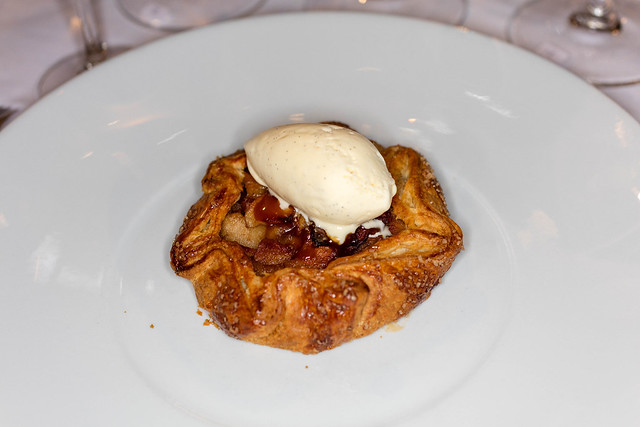
Rustic Caramel Apple Tart with Heilala Vanilla Ice Cream
1994 Fritz Haag Braunberger Juffer Sonnenuhr Beerenauslese
Medium orange color; beautiful citrus, orange and apricot aromas; rich mix of orange-infused fruit and almost maple-butter character; impressive length too; this was easily the best dessert wine of the 2008 vintage assessment series. Restored my faith that I still liked dessert wines. 95.
Hard at work
Postscript statistics and comments:
Corked - 0/13 0.0%
Other Defects – 0/13 0.0%
Advanced – 1/13 7.7%
Oxidized - 2/13 15.4%
Advanced or oxidized - 3/13 23.1%
Technically Defective in some manner 3/13 23.1%
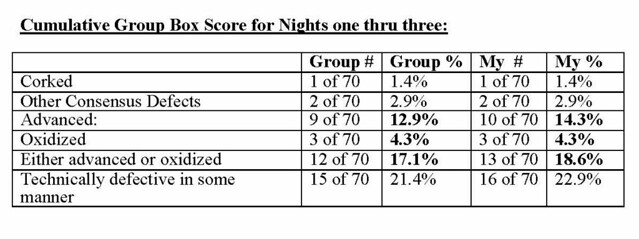
Here’s a look at the 2008 vintage performance compared with the other vintages from 1996 through 2008. Overall, the 2008s were below the average figure, but the vintage does illustrate that the premox problem continues.
Cheers and Jeers
Cheers go to:
• Coche-Dury – To me the two Coche-Dury wines (Nos. 10 and 13) were the easily most impressive wines of the Mostly Montrachet dinner
• Colin-Morey – Easily the most impressive overall producer in 2008. We had one corked wine and the other five wines were all in the top five of their respective dinners.
• Sauzet - The Montrachet helped restore my faith in this label a little after some underwhelming performances in the 2007 and 2008 vintages.
• Blain-Gagnard – Well, they at least deserve praise for producing a wine that wasn’t premoxed at 7.5 years. A pleasant surprise.
Jeers go to:
• Le Moine – another oxidized bottle (like the 2005s)
• Marc Colin - totally oxidized and coyote ugly wine
• Drouhin – the very nice 2008 Corton Charlemagne and last year’s impressive 2007 Montrachet got my hopes up, but it was not to be
• Ramonet – At the pricing that was asked by the Domaine on release for the 2008 Montrachet, a big jump over the 2007, this Montrachet was unforgiveable.
Ken Takayama, Chef de Cuisine
My perspective on the 2008 Vintage
Overall, I think the 2008 vintage is uneven. Among the Cote de Beaune wines, the botrytis and sur maturite conditions of the vintage most obviously appear in the very sweet aromas in most of the wines. Where the amount is limited, it adds an element of complexity – almost confectionery sweetness in some wines and some tropical fruit elements in others. But where the amount is excessive, the aromas and flavors push into the ripe peach, apricot and orange citrus range. As the notes over the three nights demonstrate, it was certainly possible to make great wines in 2008 if the producer was meticulous in the vineyard, sprayed the vines to avoid rot at the right times, harvested at the right time and limited or excluded the botrytised grapes. But for those who had a lot of botrytis, and who elected to include those grapes at the crusher, the resulting wines are hugely disappointing to people who expect classically styled white burgundy.
I was encouraged about the 2008 vintage based on the night one wines. The wines from Chablis and Corton Charlemagne were much more impressive as a group than their 2007 counterparts. The 2008 Meursault wines, which overall were not quite as good as their extremely impressive 2007 counterparts, were nonetheless very good to excellent overall. Some of the 2008 Meursaults were quite backward and will actually benefit from a few more years of age. In the context of the excellent performance of the best Chablis, Meursault and Corton Charlemagne, the few wines from those communes that were obviously flawed with heavy botrytis on night one didn’t seem so bothersome in context.
But as we moved to the hyphenated-Montrachet grand crus on night two, and their greater natural ripeness, it became clearer that a lot of the most expensive white burgundy real estate had some serious botrytis infestation in 2008 – but you would never have known that from reading the reviews of the individual wines that were published on release. Steve Tanzer did warn about botrytis problems in his vintage comments and there were some notes about “exotic” or atypical aromas and a few warnings about rot problems. But nobody red-flagged botrtytis in the reviews of the individual wines.
The wines from Criots and Bienvenues were generally on the slightly sweet side, but very good. But the Batard flight was downright ugly. It was easily the least impressive flight of Batard we’ve ever had. (Even the 2005s were clearly better). The two flights of Chevalier Montrachet had very mixed performance as well. The first flight of Chevalier, in which I put the wines traditionally made in a riper, more Batard-like style, were just as disappointing as the Batards. The last flight of Chevalier, despite including two disappointing ringers (one seriously advanced), and another oxidized Leflaive Chevalier, saved the day. We ended Night Two with four consecutive extraordinary Chevaliers.
The “Mostly Montrachet” night is frequently variable with some spectacular wines mixed in with some very expensive failures. So it was with the 2008s. At least four of the 13 wines were very obviously suffering from a huge amount of botrytis. I thought only 8 of the 13 wines were of an acceptable quality level. The Ramonet Montrachet, which was one of my “unacceptable quality” wines, was probably the most disappointing Montrachet I have ever encountered from Ramonet – because the decision to include the botrytised grapes and to release the obviously botrytis affected wine must have been a conscious one made by Noel Ramonet. Given the huge price asked for this wine even on release, I felt cheated. Luckily, the high pricing deterred me from buying more than one bottle of the 2008. On the other hand, the two Coche-Dury wines were exceptional as were the Colin-Morey, Sauzet and Bouchard.
From my perspective, the most successful communes in 2008 were Chablis, Corton Charlemagne, and the Meursault 1ers. For Ramonet, Colin-Morey, Jean-Marc Pillot and Bouchard (regular Chevalier), you can add Chevalier Montrachet as well.
Next year we will be tasting the 2009 whites. I fear a repeat of the problems we encountered with the 2005 vintage, which was the worst premox year to date, but we won’t know until we taste them. We will probably hold a much smaller event for the 2009 vintage. Next year will be the first year to test the effects of the new DIAM closures, which Fevre, Bouchard, Montille and others adopted starting with that vintage.
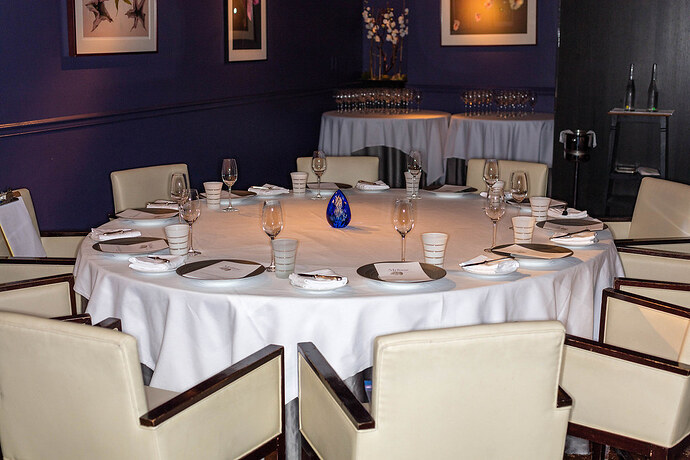
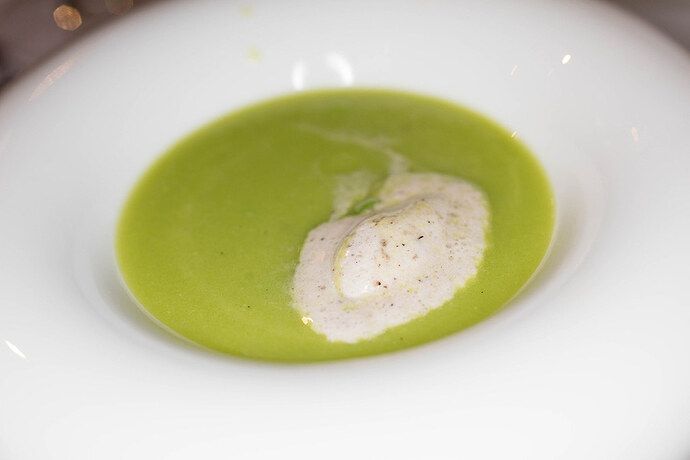
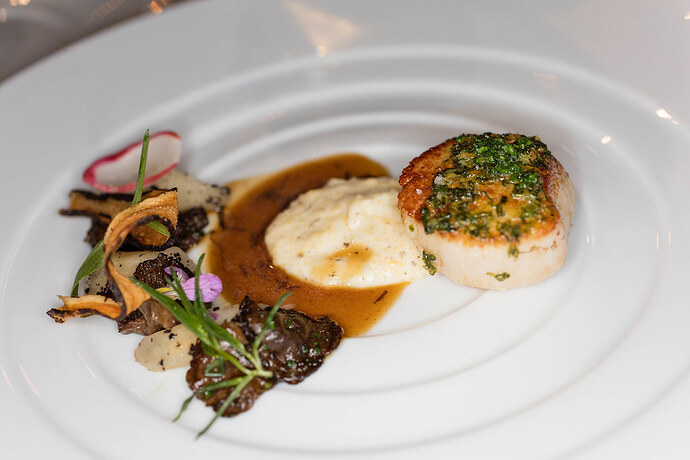
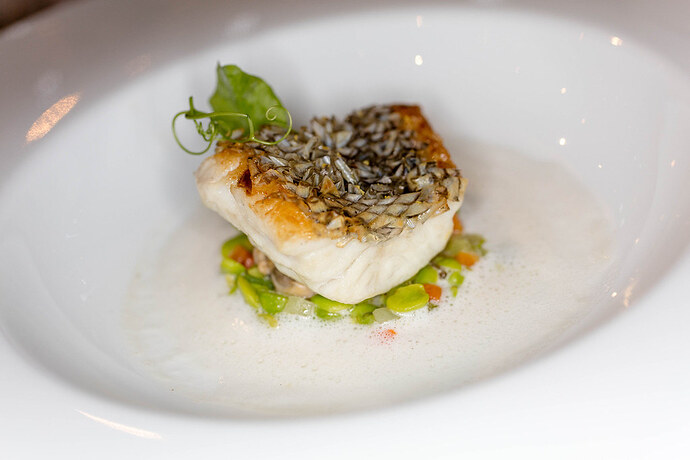
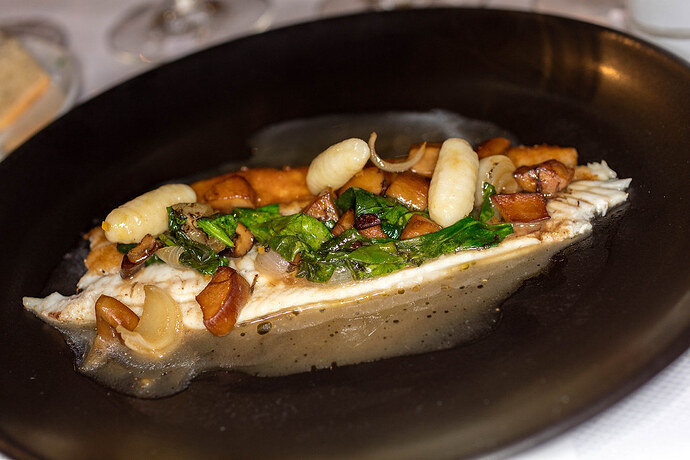
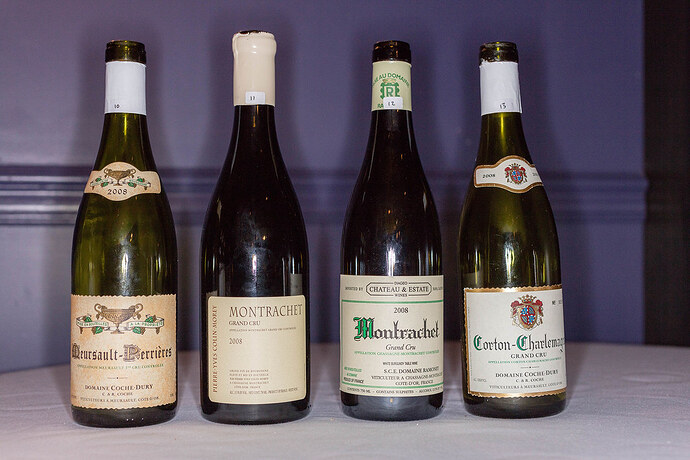
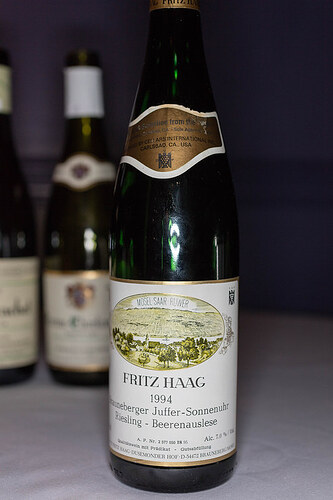
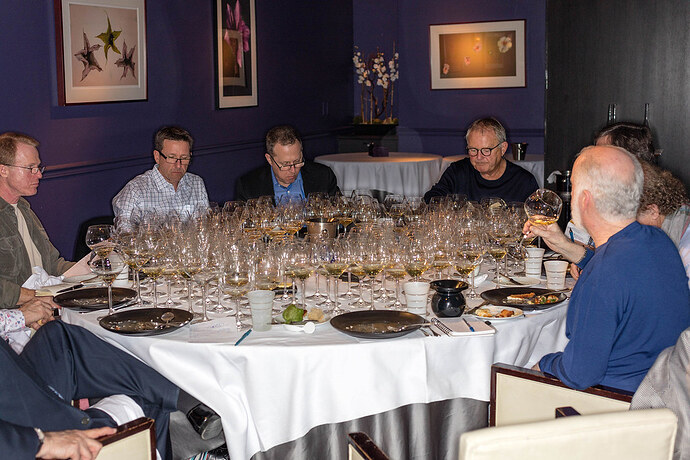
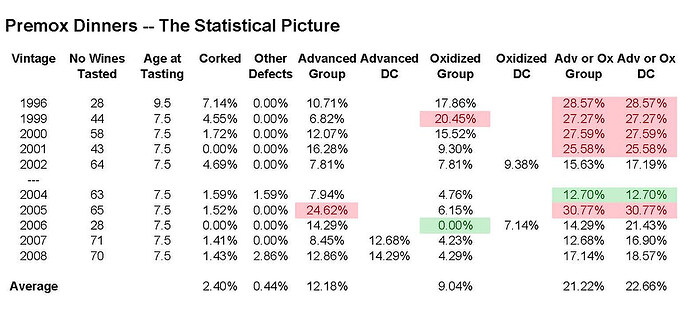
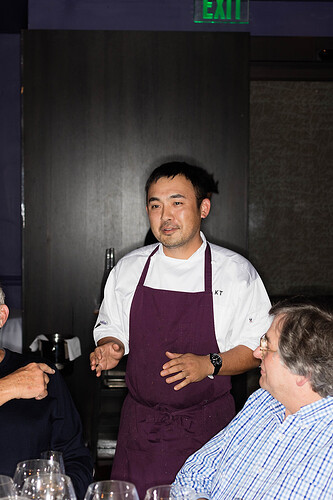

 Outstanding. Bravo!
Outstanding. Bravo!